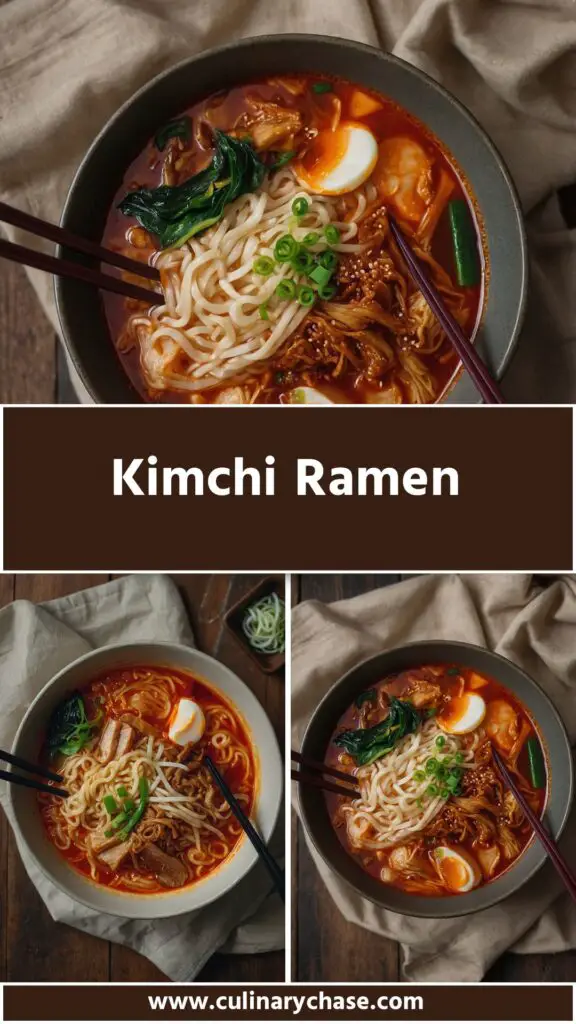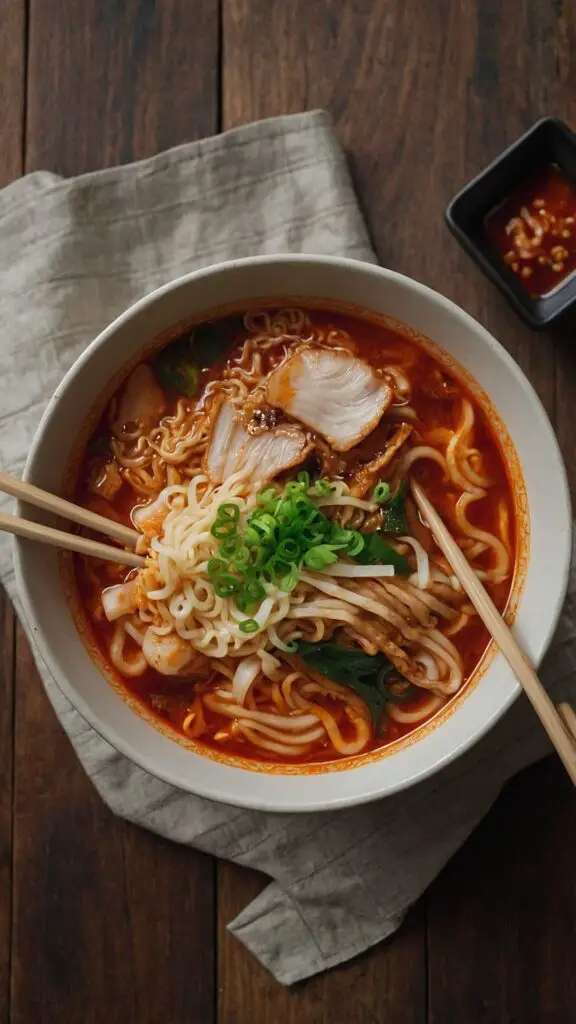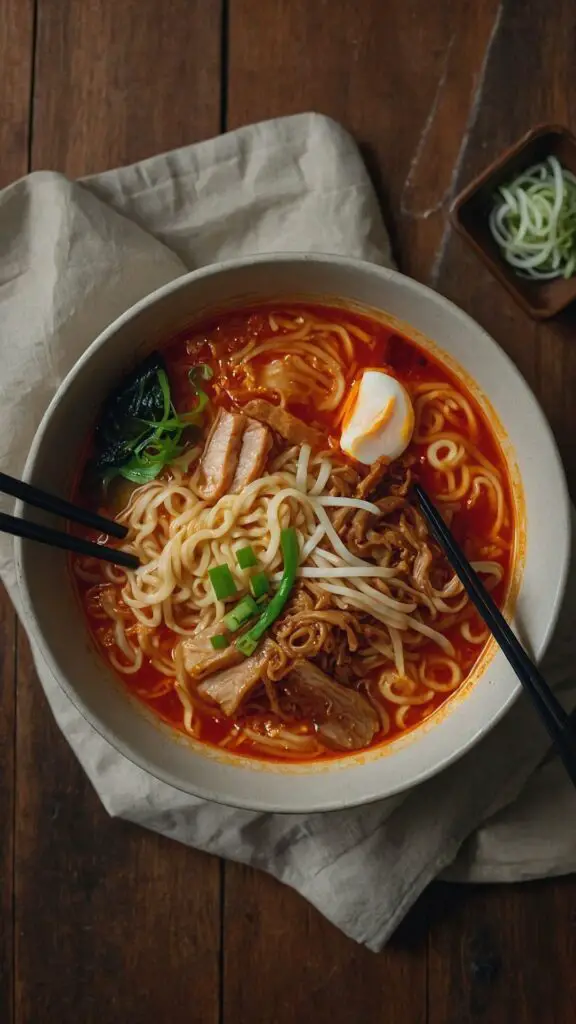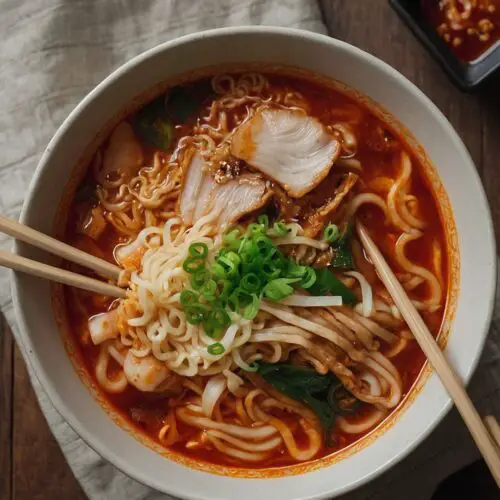Kimchi Ramen – Culinary Chase
If you’re diving into the delightful world of kimchi ramen, you might wonder what to serve alongside it. Think light, crunchy flavors that complement the rich and spicy notes of the ramen. Here are some ideas:
- Pickled Vegetables: Quick-pickled cucumbers or radishes cut the spice and add a refreshing crunch.
- Egg Rolls: Crispy on the outside and filled with savory meats or veggies, they provide a tasty, flaky contrast.
- Edamame: Steamed and lightly salted, these little pods are a protein-packed snack that balances out your meal.
- Seaweed Salad: The depth of flavor and unique texture is a great contrast to the smoothness of ramen, making for a well-rounded dining experience.

I remember the first time I tasted kimchi ramen. I was in a tiny but vibrant noodle shop, the air rich with spices. As I took a slurp, an explosion of flavors danced across my palate. It was love at first bite. Since then, I’ve made it a staple in my kitchen. This dish is not just a meal; it’s an experience filled with warmth, spice, and comfort. But what exactly is kimchi ramen? Let’s explore this fascinating dish together.
What is Kimchi Ramen?
Kimchi ramen is a fusion dish that marries traditional ramen with the bold flavors of kimchi, a staple in Korean cuisine. It typically includes noodles, a savory broth infused with kimchi, and various toppings that elevate the dish further. The tangy, spicy character of kimchi harmonizes wonderfully with the umami of ramen, making it a comforting bowl of goodness.
What Does It Taste Like?
Imagine a bowl that balances the earthiness of mushrooms, the spiciness of gochugaru (Korean chili flakes), and the tangy zest of fermented cabbage. Each sip of broth is warming. The noodles are soft yet resilient, soaking up all the flavors of the broth and kimchi.
It’s a dance of sensations—a warming hug for your taste buds. Now that you might be drooling, let’s dig deeper into why this recipe works so well.
You will also like the following Lunch and Dinner recipes!
Why This Recipe Works
1. Bold Flavors: The combination of kimchi and broth creates a rich and aromatic experience. Each bite offers layers of flavor that keep you coming back for more.
2. Nutritional Balance: Kimchi is packed with probiotics, fiber, and vitamins. Ramen, primarily made of wheat, complements this with carbs for energy. Toss in some fresh vegetables, and you’ve a well-rounded meal!
3. Quick Preparation: This recipe is perfect for busy weeknights. With most ingredients accessible, you can whip up this delicious dish in under 30 minutes.
4. Customizable: Not a fan of certain ingredients? No problem! This dish allows you to swap and change various toppings and spices without compromising the essence of kimchi ramen.
Ingredients for Kimchi Ramen
Here’s what you’ll need for a delightful serving of kimchi ramen:
- 1 teaspoon minced garlic
- 1 package instant ramen noodles
- ¼ teaspoon light brown sugar
- 5 fresh shiitake mushrooms, thinly sliced
- 2 ½ cups low-sodium chicken or vegetable broth
- 1 teaspoon light soy sauce
- 1 tablespoon neutral cooking oil (such as canola or sunflower)
- 1 scallion, cut into thin julienne strips
- 2 teaspoons Korean gochugaru (red chili flakes)
- 1 teaspoon toasted sesame oil
- ¼ cup tangy kimchi brine
- ½ cup chopped napa cabbage kimchi

Step-by-Step Instructions
Step 1: Prepare Your Ingredients
Get everything ready! Mince your garlic, slice your mushrooms, and chop the kimchi if it’s not already done. This helps things move quickly. It’s like a dance; you want to be in sync.
Step 2: Heat the Oil
In a medium-sized pot, heat your neutral oil over medium heat. Once hot, add the minced garlic. Sauté until fragrant—about 30 seconds. Be careful, as garlic can burn easily.
Step 3: Add Mushrooms and Sugar
Next, toss in the sliced shiitake mushrooms along with the light brown sugar. Stir them together and let the mushrooms soften for about three minutes. The sugar enhances the umami of the mushrooms, creating a delightful base.
Step 4: Pour in the Broth
Add the low-sodium chicken or vegetable broth to the pot. Bring it to a gentle boil. Then stir in the light soy sauce, toasted sesame oil, and kimchi brine. This is where the magic starts—we’re creating a rich, savory broth that’s full of flavor.
Step 5: Add the Noodles
Once boiling, add the instant ramen noodles directly into the pot. Cook according to the package instructions, usually about 3-4 minutes. Stir occasionally to separate the noodles and help them soak in that delicious broth.
Step 6: Stir in the Kimchi
Once the noodles are cooked, gently fold in the chopped napa cabbage kimchi and the gochugaru. This gives your ramen a spicy kick. Taste it! Adjust the flavors; maybe it needs a touch more soy sauce or a hint more spice.
Step 7: Garnish and Serve
Ladle the ramen into bowls and garnish with julienned scallions. Maybe add a little extra kimchi on top if you’re feeling adventurous! Serve hot and enjoy the explosion of flavors.
Notes
Here are some handy tips to keep close by for making the best kimchi ramen:
- Use Low-sodium Broth: It helps control the saltiness of the dish. Plus, you can always add more salt if needed.
- Fresh Ingredients: Aim for the freshest garlic and veggies you can find. They really elevate the dish.
- Don’t Overcook the Noodles: Instant noodles can become mushy if left cooking for too long. Keep an eye on them!
- Add an Egg: A soft-boiled egg on top is a great addition. It also provides extra richness.
- Adjust the Spice Level: If you’re sensitive to spice, start small with gochugaru and add more if you can handle it.
Nutrition Information
A single serving of kimchi ramen contains approximately:
- Calories: 450
- Protein: 12g
- Carbohydrates: 62g
- Dietary Fiber: 4g
- Sugars: 5g
- Fat: 15g
This can vary based on the precise ingredients and amounts you use.

How to Store the Leftovers
If you’ve got leftovers, don’t worry! Store the ramen in an airtight container in the refrigerator. It should last for up to three days. Reheat it in a pot over medium-low heat, adding a splash of water or broth to rejuvenate it. The noodles may soak up a lot of the broth, so a little extra liquid helps.
Sides for Kimchi Ramen
To elevate your meal experience, consider pairing your kimchi ramen with:
- Tonkatsu: This Japanese pork cutlet is breaded and fried. Its crispness complements the soft ramen.
- Tempura: Lightly battered and fried vegetables or shrimp bring a lovely crunch to your meal.
- Miso Soup: A light starter that doesn’t overshadow the ramen but complements it perfectly.
- Korean Fried Chicken: Its crispy skin and spicy glaze will enhance the flavors of your ramen. Who wouldn’t love this duo?
Alternative Ingredient Choices
Caught without some ingredients? Here’s a few substitutes to keep the flavor intact:
- Noodles: If you can’t find instant ramen, use soba or udon noodles. They microwave well and carry flavors wonderfully.
- Mushrooms: Any quick-cooking mushrooms will do if shiitakes aren’t available. Button mushrooms or oyster mushrooms are great alternatives.
- Kimchi: If you don’t have napa cabbage kimchi, use regular kimchi. It will change the flavor slightly but still be delicious.
- Broth: Can’t find low-sodium broth? Boil some water with vegetables for a quick broth substitute.

Kimchi Ramen
Equipment
- Medium-sized pot
Ingredients
- 1 teaspoon minced garlic
- 1 package instant ramen noodles
- ¼ teaspoon light brown sugar
- 5 fresh shiitake mushrooms thinly sliced
- 2 ½ cups low-sodium chicken or vegetable broth
- 1 teaspoon light soy sauce
- 1 tablespoon neutral cooking oil such as canola or sunflower
- 1 scallion cut into thin julienne strips
- 2 teaspoons Korean gochugaru red chili flakes
- 1 teaspoon toasted sesame oil
- ¼ cup tangy kimchi brine
- ½ cup chopped napa cabbage kimchi
Instructions
Step 1: Prepare Your Ingredients
- Get everything ready! Mince your garlic, slice your mushrooms, and chop the kimchi if it’s not already done. This helps things move quickly. It’s like a dance; you want to be in sync.
Step 2: Heat the Oil
- In a medium-sized pot, heat your neutral oil over medium heat. Once hot, add the minced garlic. Sauté until fragrant—about 30 seconds. Be careful, as garlic can burn easily.
Step 3: Add Mushrooms and Sugar
- Next, toss in the sliced shiitake mushrooms along with the light brown sugar. Stir them together and let the mushrooms soften for about three minutes. The sugar enhances the umami of the mushrooms, creating a delightful base.
Step 4: Pour in the Broth
- Add the low-sodium chicken or vegetable broth to the pot. Bring it to a gentle boil. Then stir in the light soy sauce, toasted sesame oil, and kimchi brine. This is where the magic starts—we’re creating a rich, savory broth that’s full of flavor.
Step 5: Add the Noodles
- Once boiling, add the instant ramen noodles directly into the pot. Cook according to the package instructions, usually about 3-4 minutes. Stir occasionally to separate the noodles and help them soak in that delicious broth.
Step 6: Stir in the Kimchi
- Once the noodles are cooked, gently fold in the chopped napa cabbage kimchi and the gochugaru. This gives your ramen a spicy kick. Taste it! Adjust the flavors; maybe it needs a touch more soy sauce or a hint more spice.
Step 7: Garnish and Serve
- Ladle the ramen into bowls and garnish with julienned scallions. Maybe add a little extra kimchi on top if you’re feeling adventurous! Serve hot and enjoy the explosion of flavors.
Notes
- Use Low-sodium Broth: It helps control the saltiness of the dish. Plus, you can always add more salt if needed.
- Fresh Ingredients: Aim for the freshest garlic and veggies you can find. They really elevate the dish.
- Don’t Overcook the Noodles: Instant noodles can become mushy if left cooking for too long. Keep an eye on them!
- Add an Egg: A soft-boiled egg on top is a great addition. It also provides extra richness.
- Adjust the Spice Level: If you’re sensitive to spice, start small with gochugaru and add more if you can handle it.
Nutrition
Frequently Asked Questions
1. Can I make kimchi ramen vegetarian?
Absolutely! Use vegetable broth and skip any animal-based toppings. The dish will remain rich and flavorful with the right broth and spices
2. Is kimchi ramen spicy?
It has a mild kick from gochugaru and fermented kimchi. You can adjust the spice level to your taste by reducing the amount of gochugaru used.
3. How do I know when the noodles are perfectly cooked?
Instant noodles are usually cooked al dente when they are still slightly firm to the bite yet fully cooked through. Follow package instructions for tim
4. Can I add other proteins to the ramen?
For sure! Add tofu, chicken, or beef. Cook them separately, then add them in just before serving for the best flavor and texture.
Conclusion
From the sizzling garlic in the oil to the luxurious broth bursting with flavor, kimchi ramen is more than just a meal; it’s a celebration of culinary contrast. Each element plays a role in creating a bowl worthy of any dinner table. Plus, with its variety of ingredient options, you can make it yours every time—just like I do. So grab your ingredients, roll up your sleeves, and dive into making this delightful dish. You’ll be serving up smiles, one bowl at a time!
